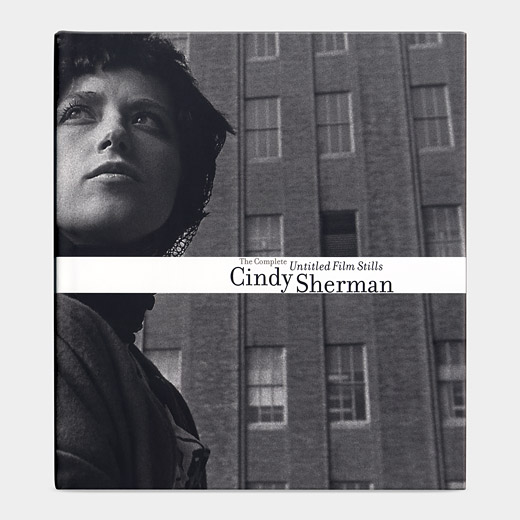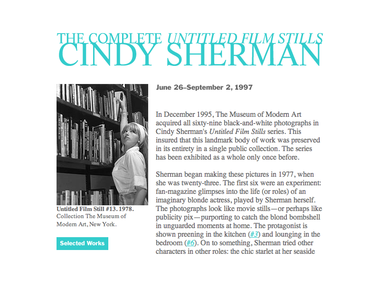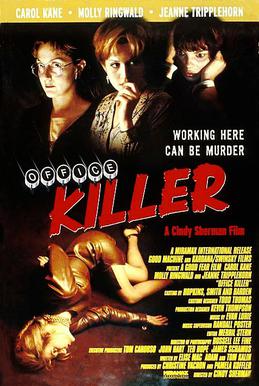 [Toward the tail end of my decade as the photography critic for the New York Observer I had the opportunity to review the Museum of Modern Art’s celebration of Cindy Sherman’s “Untitled Film Stills” series, a complete set of which they had recently acquired and were showing for the first time, in an exhibition sponsored by Madonna.
[Toward the tail end of my decade as the photography critic for the New York Observer I had the opportunity to review the Museum of Modern Art’s celebration of Cindy Sherman’s “Untitled Film Stills” series, a complete set of which they had recently acquired and were showing for the first time, in an exhibition sponsored by Madonna.
I used the occasion to move between textual and contextual analysis, the latter taking the form of what the Germans call “ausstellungskritik.” The term doesn’t translate readily into English; literally it’s “exhibition criticism,” but in the original it denotes a critique of the presentational project, as distinct from a critique restricted to the work itself. I thought that approach would help my readers grasp the true significance of the event.
A MoMA monograph including all the images with accompanying essays — effectively, a catalog of the show — appeared belatedly in 2003. Click here for the show’s original press release. The review appeared under the title below on July 21, 1997, exactly 20 years ago. — A. D. C.]
•
Cindy Sherman at MoMA: The Apotheosis of an Insider
Photography drew my critical attention in the late 1960s for a variety of reasons. As a vehicle for basic visual communication, it was democratically accessible and widely if not universally practiced. As a mass medium, it was pervasive, omnipresent. And as a medium for creative expression it functioned, almost by definition, as a form of what some now call “outsider” art.
No more. In the mid-’60s, driven by student demand, the integration of photography into art-department and art-school curricula in this country began in earnest. Consequently, in the 1970s photography shifted status more abruptly and dramatically than had any previous medium, moving with breathtaking speed from “outsider” status to what must be the logical converse: “insider” art. And the Museum of Modern Art’s acquisition last year of a complete set of Cindy Sherman’s black & white 69-print “Untitled Film Stills” series for a reported $1 million, and its presentation of that body of work now, must be understood as a sociological event: the apotheosis of photography as “insider” art.
•
I often speak to my students about what I call the “empty vessel” concept of art — the notion that a work of art is merely a convenient receptacle into which we’re free to pour whatever ideas, attitudes and feelings we happen to have on hand at the moment. That’s a fallacy in the viewer, in my opinion. All responses to a work of art do not carry equal weight; all interpretations are not equally valid. Distinctive works of art, in my experience, resist and confound certain reactions, encourage others. (Responding to a Cézanne still life by discussing your personal preferences in fresh fruit misses the point.) This assumes, of course, that the work embodies some specific content the maker sought to transmit or make available.
But suppose the artist in fact sets out to craft an empty vessel, designs it to accept whatever one wants to dump there? How does one judge such a work? Surely not by the same gauge one would apply to a Cézanne. Seems to me that the number of people it enticed into depositing their baggage therein would serve as the only possible measuring device. And by that standard it appears to me that Ms. Sherman’s project constitutes a genuine triumph.
And here is the crux of the matter, as I see it: That was the plan. The goal was not to generate and record convincing performances; what she set out to imitate were usually marginally skilled actresses in poorly limned roles. Nor was the purpose to make memorable images; these are, after all, deliberately mediocre imitations of hack work, film stills from B movies. Nor was the goal to make distinctive objects; film stills are mass-produced for distribution, casually crafted as artifacts, and a good reproduction suffices as an encounter with any of them — no one actually needs to see or study these prints in order to understand the work.
Indeed, I’ll go a step further: No one needs to even see any of these pictures, in the original or in reproduction, in order to opine about them knowledgeably and use them as a reference point. That embodies their true genius. A simple verbal formulation of their premise — “a series of simulated film stills in which a single young woman stages and acts out the different stereotypical roles of 1950s B-movie actresses” — functions as a fully adequate substitute for the actual experience of the works themselves.*
In short, we have here a canny aspiring insider’s strategy, the quintessence of work consciously tailored to be written about, custom-built to serve the needs and desires of a specific generation of critics. Picasso once said, “I don’t want there to be three or four thousand possibilities of interpreting my canvas. I want there to be only one. … Otherwise a painting is just an old grab bag for everyone to reach into and pull out what himself has put in. I want my paintings to be able to defend themselves, to resist the invader, just as though there were razor blades on all the surfaces …” Well, no razor blades here. To the contrary, here’s Ms. Sherman’s message to those three or four thousand hungry opinionators: Lunch is served.
Fact is, there’s no theory — of culture, of gender politics, of psychoanalysis, of “visuality,” of the simulacrum — that these images cannot be used to illustrate, no notion, trendy or otherwise, that anything obdurate in them will contradict or refute. We have here, after all, images of a woman playing the role of a woman playing the role of a woman. In the recursiveness of that infinity of mirrors, Ms. Sherman becomes the lady from Shanghai, with no disillusioned Orson Welles determined to break the spell. Or, to put it another way, this is the one-size-fits-all of contemporary photography, with Ms. Sherman as the art world’s equivalent to Woody Allen’s Zelig or Jerzy Kosinzki’s Chauncey Gardiner, all things to all people. Form follows function: woman as perfect and passive vessel, receptive to whatever one cares to project, shape-shifter (extra)ordinaire.
As I said, writing about this does not require close attention to the pictures themselves, only minimal knowledge of the concept on which they’re based. One can read the voluminous commentary for which Ms. Sherman’s work has served as springboard and find many things: discussions of various feminisms, the “male gaze,” mimesis, Kant, Hegel, Freud, Lacan, Barthes, Kristeva, Foucault. Here’s what you won’t find, no matter how hard you search: any discussion of her picture-making strategies, the ways in which individual scenarios are constructed and their renditions crafted, choices of point of view, the strengths and weaknesses of particular pictures, actual formal relationships between her works, close comparisons to generic film stills.
In fact, when paid such attention certain unmentionable issues become foregrounded. A number of these images reveal technical and/or stylistic flaws and inconsistencies that would make them unusable as film stills. Half a dozen are severely reticulated (a visible puckering of the emulsion that results from careless processing of the film). One is drastically overexposed. Several are so out of focus that they come closer to mid-century pictorialism than anything Hollywood would tolerate. A significant percentage more resemble paparazzo reportage than on-set coverage. And so on.
I wouldn’t claim familiarity with the complete critical literature now barnacling this body of work, but I’ve nowhere found even a mention of such matters. This speaks of various tendencies among my colleagues — an avoidance of the real spadework of scholarship (by which I don’t mean re-reading Lyotard); an ongoing ignorance of the basics of photography; an actual aversion to discussing the specifics of works of art. Instead, as Peter Galassi, MoMA’s Chief Curator of Photography, says in an accompanying handout, since these pictures were made “everyone [has been] telling us what she meant. The sheer volume of verbiage — the banal and bombastic along with the thoughtful and perceptive — is a symptom of the nature of Sherman’s achievement (and now part of its meaning).”
He could not speak more plainly: regardless of quality, the physical amount of commentary evoked by Ms. Sherman’s project establishes its significance — and (tacitly) justifies the Department of Photography’s acquisition of a full set thereof for a market-making price.
Now this will shock many of my readers: I agree with him. I don’t think my opinion of these pictures, or the larger project they constitute, matters. In the two decades since their maker undertook their production, they’ve become an international reference point not only for critics and other art-world types but for a large segment of the general public. The art world working as it does, they’re in forever — even if, like Bougereau, Ms. Sherman eventually falls out of critical favor. So they’ve earned a de facto importance, and Mr. Galassi’s acquisition of them signals most visibly his ongoing efforts to stretch his department’s parameters beyond the rigid modernism of his mentor and predecessor, John Szarkowski.
Ultimately, one must admire the carefully plotted trajectory of this work. Commenced in 1977, when Ms. Sherman was only 23, shortly after she received her B.A. from the State University at Buffalo (where she studied with one of the masters of directorial photography, Les Krims), it made its debut at the Center for Exploratory and Perceptual Arts/Hallwalls, a not-for-profit artist-run outfit in Buffalo that her cohort used as a showcase. (Now there’s a real subject for art-historical research, though I fear Mr. Galassi is right in prophesying that, instead, “Eventually a small army of cinema scholars will map Sherman’s Stills against film history.”) A mere year later it had made its way to New York City. It was initially positioned as exemplifying a kind of post-modern anti-photography — and certainly challenged MoMA’s then-current position on that subject; Ms. Sherman consistently resisted identification as a photographer, despite her choice of medium.
Today, just twenty years on, that same body of work has found a permanent home in the very bastion of modernism, and in its department of photography to boot, at a record price; it, and its maker’s name, are on everyone’s lips; it has become an acknowledged part of art history. To whatever Ms. Sherman sets her hand from now on — even the recently completed feature film her dissatisfied producers have withheld from distribution[1] — attention must and will be paid. What arc of triumph from insider-aspirant to insider-queen could be more perfect and — for those who admire such things, however grudgingly — more admirable?
•
*See, in this regard, my 2013 series of posts “How to Talk Through Your Hat.”
[1] The film, Office Killer, did get released; see “A Horror Movie, Complete With Zombies” by Roberta Smith, New York Times, November 30, 1997. According to Wikipedia, it grossed a total of $37,446. For an account of its producers’ lack of enthusiasm, see “Art Diary: ??” by Jeffrey Hogrefe, The New York Observer, Vol. ??, no. ?? ??, 1997), p. ??. (My apologies for the untypical incompleteness of this citation, and my thanks to any reader who can flesh it out.)
•
This post sponsored by a donation from photographer Chuck Kimmerle.
 Special offer: If you want me to either continue pursuing a particular subject or give you a break and (for one post) write on a topic — my choice — other than the current main story, make a donation of $50 via the PayPal widget below, indicating your preference in a note accompanying your donation. I’ll credit you as that new post’s sponsor, and link to a website of your choosing. Include a note with your snail-mail address (or email it to me separately) for a free signed copy of my 1995 book Critical Focus!
Special offer: If you want me to either continue pursuing a particular subject or give you a break and (for one post) write on a topic — my choice — other than the current main story, make a donation of $50 via the PayPal widget below, indicating your preference in a note accompanying your donation. I’ll credit you as that new post’s sponsor, and link to a website of your choosing. Include a note with your snail-mail address (or email it to me separately) for a free signed copy of my 1995 book Critical Focus!
 But wait! There’s more! Donate now and I’ll include a copy of The Silent Strength of Liu Xia, the catalog of the 2012-13 touring exhibition of photos by the dissident Chinese photographer, artist, and poet, currently in her sixth year of extralegal house arrest in Beijing. The only publication of her photographic work, it includes all 26 images in the exhibition, plus another 14 from the same series, along with essays by Guy Sorman, Andrew Nathan, and Cui Weiping, professor at the Beijing Film Academy.
But wait! There’s more! Donate now and I’ll include a copy of The Silent Strength of Liu Xia, the catalog of the 2012-13 touring exhibition of photos by the dissident Chinese photographer, artist, and poet, currently in her sixth year of extralegal house arrest in Beijing. The only publication of her photographic work, it includes all 26 images in the exhibition, plus another 14 from the same series, along with essays by Guy Sorman, Andrew Nathan, and Cui Weiping, professor at the Beijing Film Academy.









There was a time when 20th century art (especially photography) was made from an inherent commitment (or inner need) to share with curious others something visually meaningful to the maker. Room and board were secured by other means. Somewhere along in the later 20th century, photography joined (or was conjoined to) the purpose of Wall Street. That purpose even became a focus of graduate art programs in universities. Today that purpose often seems to be a (the?) primary focus of makers and “responders.”
The problem as I see it is not related to people hoping to “secure room and board” from their art-making practice, or at least from some marketable application of their craft skills. Any number of people have done so over the centuries, with various degrees of success. Nothing inherently wrong with that, in my opinion. (Of course, I speak here as someone who has earned at least part of his living from his writing skills for the past 50 years.)
But we live in the first society that has ever produced many more artists than it could reasonably support, resulting in much more art than it can possibly consume. And the bulk of that production of supply without commensurate demand has come from and through the academic sector, whose studio art programs in all media have cranked out more fledgling artists than would have emerged and contended for public attention were they not deeply invested (financially and otherwise) in their academic credentials as artists.
So, as someone who taught part-time in studio-art photo programs, responding to a full-time tenured (and now emeritus) academic, I suggest that we need to consider our own roles in bringing about the current situation. I try to do so periodically, as some of the posts here, recent and archival, suggest. You might try it yourself.
Among the pleasures of this Sherman critique was the dart-sharp use of barnacle as verb. It also prompted three related memories from a somewhat earlier time.
#1, In a 1970 workshop at the Center of the Eye I had participants blindfold themselves, then respond to a description of a photograph none had seen. It was a very agreeable experience and generated more discussion than typically resulted from viewing photographs.
#2, In 1977, a friend who teaches literary theory called to urge me to see Douglas Crimp’s show, Pictures, at Artists Space, saying finally there was a show of photographs that made sense. It was the first time I had seen the work, and whatever my limitations I think of myself as an informed audience for photographs- I now understand I was looking for something that was actively suppressed, making that unvisual show startlingly invisible to me.
#3, At a lecture around the same time, the speaker asserted that neither the work of Lee Friedlander nor Edward Weston was interesting, for the same reason, which I failed to grasp, so I asked. The answer was that they both employ formal means. When I suggested that criticism would include pretty much all art ever made, she agreed.
Let’s see, where was I?
Since there’s an adjectival form of barnacle, which resembles a past tense (“barnacled”), I indulged myself in a present-tense verb-form neologism. Glad you noticed and enjoyed it.
As you point out, the issues I raised re Sherman’s work pertain more broadly to pomo photography — and, indeed, to pomo art in general.
Elsewhere I have elaborated the theory that this resulted from their educational encounter with works of visual art having relied almost entirely on projected 35mm slides, which render iconography but emulsify and/or eliminate anything distinctive about a given object’s physicality and/or facture.
I think you were about to say that now you understand why you have never felt the need to return to the actual presence of any pomo photographic work in order to engage with it more deeply.
By the way, I enjoy your exercise (#1). Who did the describing of the photograph — you, as workshop leader? And was it an actual photograph you described, one that they later got to see, or an imaginary one?